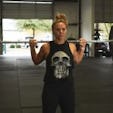All my workouts involve one thing: calisthenics, or bodyweight exercises. I do all my workouts on parallel bars, pullup bars, or on the ground.
I used to be into heavy powerlifting, but recently moved to a purely bodyweight training regimen.
I noticed a big change in both my physique and strength.
I actually felt a difference in my body; doing my unique exercises opened up a totally new door.
I noticed I was using muscles that I had never even used before.
Believe it or not, all my workouts involve calisthenics circuit routines now. In a circuit, you move from one exercise to the next with little or no rest between moves.
Circuit training doesn’t allow your heart to rest or slow down. It keeps it up consistently throughout your workout allowing you to burn more calories and build conditioning.
I do hundreds of different calisthenics circuits and I never touch the weights. I’ve lost 37 pounds of fat in six months doing my exercises. I went from 202 pounds to a lean 165 pounds.
I get at least 50 messages a day just on my transformation and how I did it.
The best part is, anyone can do it themselves with hard work and dedication.
I’m going to share four of my circuit workouts with you. One is for beginners and can be done at home. Two are for intermediate and advanced exercisers, and one is only for extreme athletes.
Find the workout that’s best for you and, if you stick to it, you will see results in less than two months.
How Long Should You Train For In a Calisthenics Workout?
The At-Home (beginner level), Intermediate, and Extreme Athlete routines shown here should all take 30 minutes or less to complete. The Advanced workout may take as long as 45 minutes. In general, you can save time by trying to move at a brisk pace between exercises and circuits, but give yourself enough rest time so that you can complete your exercises safely and with good form. You can work on reducing rest periods as your conditioning improves over time. Have a timer handy to track the length of your sets and your rest periods; you’ll need one for the Advanced and Extreme Athlete workouts.
How Long Should You Recover After A Calisthenics Workout?
Each of these workouts can be performed up to four times per week on non-consecutive days. Three to four workouts per week is enough. For example, Monday, Wednesday, Friday, and Sunday. You can also combine them, performing the At-Home workout one day, the Intermediate on another, and the Advanced (if you dare!) on a third day. If you feel extra sore or run down on a day you had planned to train, take another day’s rest before your next workout (or perform light exercise or aerobic activity, such as walking/jogging, cycling, yoga, mobility work, etc.).
Calisthenics Vs. Weight Training
The term calisthenics refers to training that uses primarily bodyweight exercises to develop strength, endurance, mobility, and coordination. It’s the kind of exercise that gymnasts and martial artists have done for eons using their own body weight, and while it develops muscle mass too, that’s more of a byproduct. You can expect to get very strong relative to your bodyweight when you do calisthenics training, and master your control of your body in various positions and movements. I.e., you’ll become stable and athletic.
Weight training uses external loads—free weights, cables, machines—to strengthen the body, and while it can develop the same qualities that calisthenics can, it’s better-suited for those who want to build maximum muscle mass, power, and absolute strength. This makes it a potentially better choice for athletes in sports like football, baseball, and track and field. A gymnast will usually be able to do more pullups and pushups than a bodybuilder or powerlifter, but the one who lifts heavy weights can probably move more overall load and will look bigger and stronger. Neither kind of training is superior to the other— both have their advantages, depending on your goals.
For the best, most well-rounded results, include both calisthenics, cardio and weight training in your regimen. You can alternate the styles, spending a few weeks working on one and then switch to another, or you can combine them in the same workout. For instance, you can start with weight training exercises to peak your power and strength, and then finish your routine with bodyweight training that works more on endurance and movement skills.
How To Stretch For A Calisthenics Circuit Workout
Follow the video below for a routine to warm up your entire body before the calisthenics workouts offered here. For more tips on mobility and stretching, follow Onnit-certified Durability Coach Brian Butz (aka @themobilemammoth on Instagram).
1. Lateral Squat to T-Spine Rotation
Sets: 2–5 Reps: 5–10
[See 00:58 in the video above]
Lunge out to your left side and lower your body until your left leg is bent about 90 degrees and your trailing leg is straight. Hold for a moment, and then reverse the motion, twisting your body to get into a lunge position on the right leg, facing that direction.
Plant your left hand on the floor and twist your torso to the right, reaching your right hand overhead.
Repeat the entire movement on the opposite side.
2. Adductor to T-Spine Rotation
Sets: 2–5 Reps: 5–10
[See 01:30 in the video]
Get on all fours and extend your right leg to the side. Use your hands to gently push your hips back so your feel a stretch on the inner side of your right thigh. Allow your foot to roll backward and point upward.
Push your hips forward again and twist your torso to the right, reaching your right arm overhead. Complete your reps and then repeat on the opposite side.
3. Mountain Climber to Hip Flexor Stretch
Sets: 2–5 Reps: 5–10
[See 02:00 in the video]
Get on all fours, and then step your left foot forward, planting your foot outside your left hand. Try to straighten your back so that it’s flat from your head to your pelvis. Relax, and reach back to grasp the top of your right foot.
Gently pull it forward so you feel a stretch on your right thigh and hip. At the same time, extend your back and use your left hand to push on your left knee so you end up in a tall kneeling position.
Hold the stretch for a moment, and then let your right foot go. Repeat the movement on the opposite side. Avoid hyperextending your lower back when you pull on your foot.
4. Shinbox to Hip Extension
Sets: 2–5 Reps: 5–10
[See 03:06 in the video]
Sit on the floor with your left leg bent in front of you and your right leg bent behind you. Press your hands into the floor and push your chest up and out. Now rotate your right leg up off the floor as you rotate your left leg up and to the right, so your body turns and you end up in the same starting position but with your legs opposite. From there, extend your hips so you rise to a tall kneeling position.
Lower your hips back to the floor, plant your hands, and repeat the movement to the other side.
At-Home Calisthenics Circuit Workout
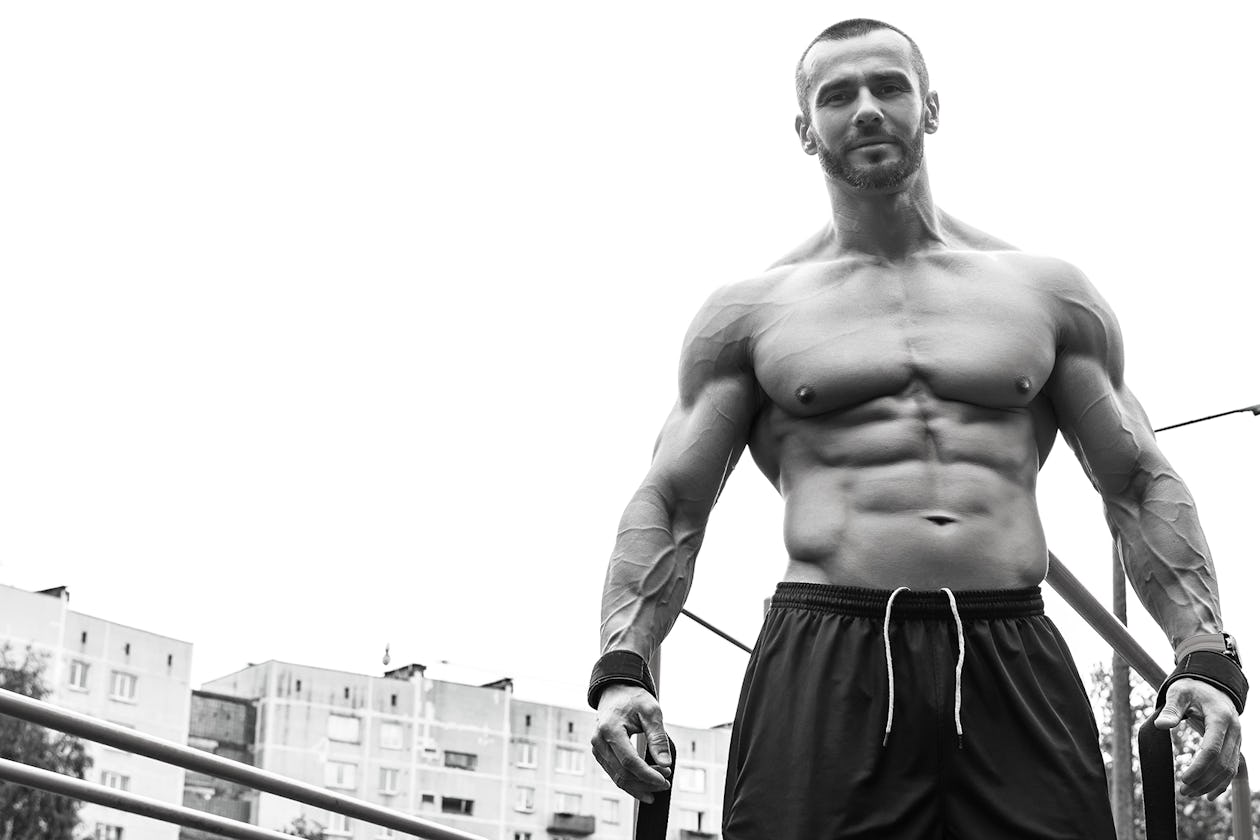
Here’s a bodyweight workout that’s appropriate whether you’re a total beginner to training or you have a little experience with lifting weights but you want to get back to basics with calisthenics training. You can do this routine at home if you have a pullup bar, and it may help to have an elastic exercise band as well, which can help to unload some of your bodyweight and make exercises like chinups and dips easier.
Perform the exercises as a circuit, completing one set for each in sequence. Rest 60 seconds between exercises, and repeat the circuit for 3 total rounds. Except where otherwise noted, do as many reps as possible for each exercise, but stop one short of failure—that means when you feel your form is about to break down. For example, if you’re doing chinups and you get to the eighth rep and feel like you’re slowing down and won’t get a ninth rep with good form, stop the set there.
1. Chinup
Reps: As many as possible
[See 00:49 in the video above]
Use a shoulder-width grip and turn your palms to face you. If you can’t get at least 5 reps on your own, attach an elastic exercise band around the bar and stand in the open loop to unload some of your bodyweight.
2. Dip
Reps: As many as possible
[See 01:00 in the video]
Lower your body until your upper arms are parallel to the floor. If you can’t get at least 5 reps on your own, attach an elastic exercise band to the dip bars and stand (or kneel) in the open loop to unload some of your bodyweight. If you don’t have dip bars, you can use the backs of two chairs.
3. Jump Squat
Reps: As many as possible
[See 01:15 in the video]
Stand with feet between hip and shoulder-width and quickly lower your body until your thighs are parallel to the floor. Explode upward as high as you can. Land softly, and reset yourself before you begin the next rep.
4. Pushup
Reps: As many as possible
[See 01:28 in the video]
Place your hands just outside shoulder width and lower your body until your chest is about an inch above the floor. Keep your body in a straight line with your core braced. Your lower back shouldn’t arch and your elbows should point 45 degrees from your torso.
5. Crunch
Reps: As many as possible
[See 02:08 in the video]
Raise your torso until your shoulder blades are off the floor.
6. Mountain Climber
Reps: Go for 30 seconds
[See 02:19 in the video]
Stand with feet shoulder width and squat down to place your hands on the floor. Now shoot your legs behind you fast so you end up in the top position of a pushup. Jump your legs back up so they land between your hands and then stand up quickly.
BONUS: Jump Rope
Reps: Jump for 30 seconds
[See 02:26 in the video]
If you have a jump rope, jump for 30 seconds, landing on the balls of your feet. Any type of jump is OK, or mix a few together.
Intermediate Calisthenics Circuit Workout
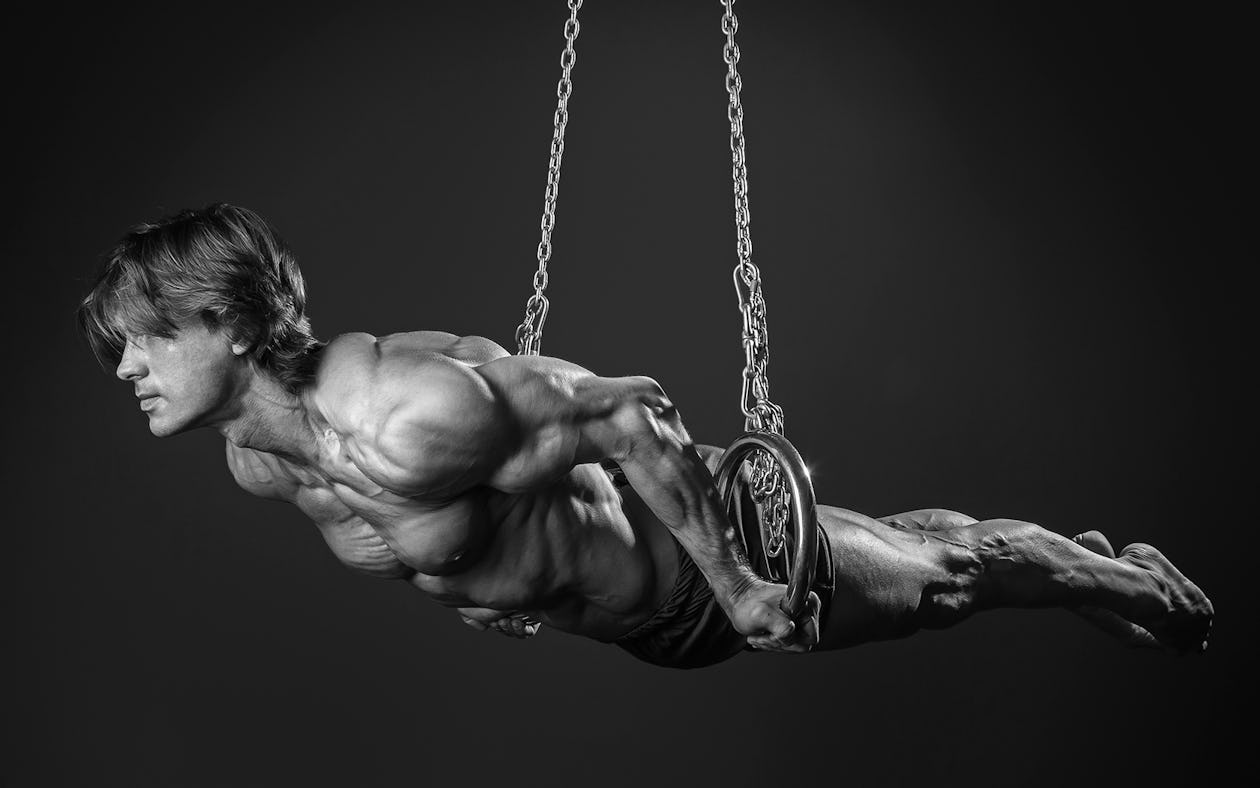
This workout is good for people with a year or more of strength training or bodyweight-only training under their belt. You can do it at home, but you’ll need a pullup bar and some space to run, so a public park or a gym may be more appropriate.
Perform the exercises as a circuit, completing one set for each in sequence. Rest 60 seconds between exercises, and repeat the circuit for 3 total rounds. Except where otherwise noted, do as many reps as possible for each exercise, but stop one short of failure—that means when you feel your form is about to break down. For example, if you’re doing jump squats, you might get to rep 10 and feel like you’re slowing down. If you’re pretty sure you won’t be able to get the 11th rep at the same speed or with a safe landing, stop the set there.
1. Feet-Elevated Pushup On Rings
Reps: As many as possible
[See 00:58 in the video above]
Set the handles of a suspension trainer around shin level and rest your feet on a bench behind you. Suspend yourself over the handles in a pushup position and then lower your body until your chest is just above your hands. Keep your body in a straight line with your core braced.
2. Feet-Elevated Inverted Row
Reps: As many as possible
[See 01:20 in the video]
Set the handles of a suspension trainer low enough so that when you hang from them with arms extended, your body is angled 45 degrees to the floor, or lower. (If you’re strong enough, rest your feet on a bench for an added challenge.) Keep your body in a straight line and brace your core as you pull yourself up.
3. Jump Squat
Reps: As many as possible
[See 01:39 in the video]
Stand with feet between hip and shoulder-width and quickly lower your body until your thighs are parallel to the floor. Explode upward as high as you can. Land softly, and reset yourself before you begin the next rep.
4. Burpee
Reps: As many as possible
[See 01:55 in the video]
Stand with your feet between hip and shoulder width, and squat down to place your hands on the floor in front of you. Jump your legs back into the top of a pushup position, then reverse the motion to come back up to standing.
5. Leg Flutter
Reps: Repeat for 60 seconds
[See 02:38 in the video]
Flatten your lower back into the floor and brace your abs. Extend your legs overhead and then lower them as far as you can before you feel your lower back is about to buckle up from the floor. Begin raising and lowering both legs, alternately, a few inches (as if you were kicking your legs while swimming).
6. Sprint
Reps: Run for 30 seconds
[See 02:58 in the video]
Run as fast as you can maintain for 30 seconds. Other options are to run up a hill, or run in place.
Advanced Calisthenics Circuit Routine
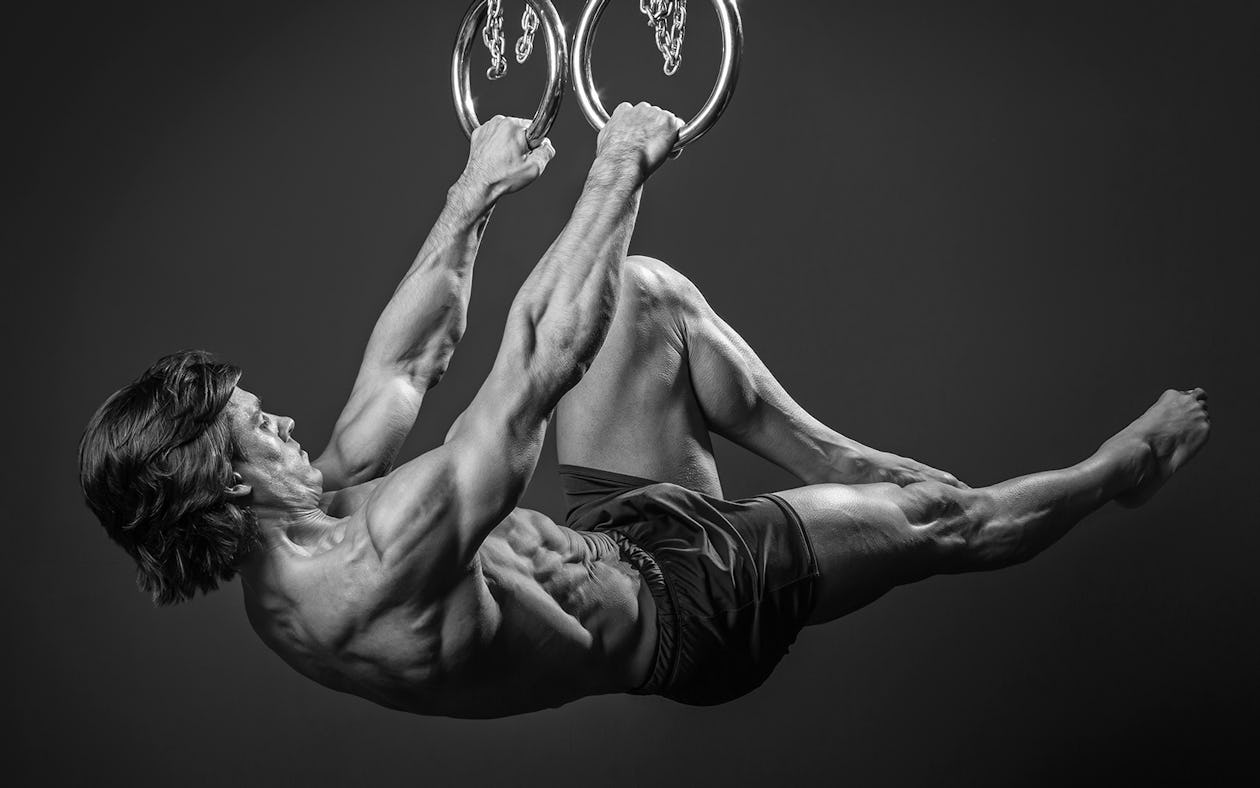
If you’ve been training for a few years and feel pretty strong on bodyweight exercises, give this advanced routine a shot.
Perform the exercises as a circuit, completing one set for each movement in sequence. Set a timer and perform each exercise for 30 seconds. Try to limit your rest between exercises. Do 1–3 total rounds.
1. Crow Pose
Reps: Hold for 30 seconds
[See 00:28 in the video above]
Get into a deep squat position and plant your hands on the floor. Tip your body forward and rest your knees on your elbows. Extend your back and hips so that your bodyweight is supported on your hands, and hold the position.
2. Jump Squat with Rotation
Reps: Jump in the 3 directions shown for 30 seconds
[See 01:02 in the video]
Lower your body into a squat quickly and then explode upward as high as you can. Swing your arms back as you go down, and throw them forward as you jump. Land softly, driving your knees outward. Hop 90 degrees to your right side, and repeat the jump. Hop back to face forward again, jump, and then rotate to face your left side, and jump again. Continue in this manner, jumping in the three different directions. Don’t let your knees cave inward on your landings, and make each jump as vertical as possible.
3. Hindu Pushup
Reps: Repeat for 30 seconds
[See 01:40 in the video]
Get into pushup position and drive your hips backward as you extend your arms overhead. You’ll end up in a downward dog pose. Now lower your chest toward the floor in an arcing motion, finishing the pushup with your chest facing forward and your hips just above the floor (an upward dog pose). Keep your core braced so that your ribs don’t flare, and avoid shrugging your shoulders. Keep your shoulder blades together and pulled downward as you move toward the floor, and spread them apart as you push up.
4. Candlestick Roll
Reps: Repeat for 30 seconds
[See 02:30 in the video]
Get into a deep squat and roll backward onto your shoulders. Roll forward again and go into the bottom of a deep lunge with your back knee pointing 90 degrees to the side. The heel of your front foot should stay flat on the floor. Repeat on the other side.
5. Lateral Squat w/ Rotation
Reps: Repeat for 30 seconds
[See 02:59 in the video]
Shift your weight to your left leg so you feel like you’re sitting into your left glute. Now raise your right knee up and outward, planting your right foot on the floor at a 90 degree angle—both heels should be in line. Lower your body into a squat, keeping a long spine from your head to your pelvis. Alternate sides each rep.
6. Xs and Os
Reps: Repeat for 30 seconds
[See 03:25 in the video]
Lie on your back and extend your arms and legs to form an X shape. Flatten your lower back into the floor. Perform a crunch, drawing your knees to your chest along with your arms.
7. Planche with Scapular Protraction
Reps: Repeat for 30 seconds
[See 03:46 in the video]
Get into pushup position and turn your palms around so that your fingers point behind you. Hold your body in a straight line with your core braced and squeeze your shoulder blades together so that only your torso moves closer to the floor. Spread your shoulders apart to raise it back up while you hold your body in position.
8. Jumping Lunge
Reps: Repeat for 30 seconds
[See 04:16 in the video]
Get into a lunge position—rear knee just above the floor and front knee bent 90 degrees. Jump and switch legs in mid air, landing with the opposite leg forward. Drive the arm that’s opposite the front leg forward on every rep.
9. Lateral Hop
Reps: Repeat for 30 seconds
[See 04:55 in the video]
Hop side to side, landing with control. It may help to place an object on the floor to jump over.
10. L-Sit Pullup
Reps: Repeat for 30 seconds
[See 05:10 in the video]
Grasp the bar with hands outside shoulder width. Raise your legs up straight in front of you as you pull your body up until your chin is over the bar.
Extreme Athlete Calisthenics Circuit Routine
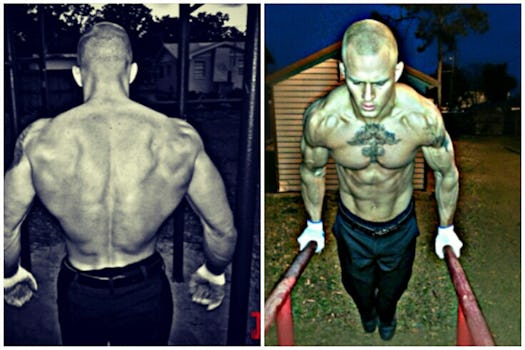
This workout is for very strong individuals who feel they’ve mastered their bodyweight on the basic exercises. It will challenge you with different movements you’ve probably never tried before, many of which are borrowed from the routines of gymnasts and MMA fighters.
Perform the exercises as a circuit, completing one set for each movement in sequence. Perform each exercise for the amount of time shown, and rest 30 seconds between exercises. Do 3 total rounds of the circuit, resting as little as possible between rounds.
1. Hanging Somersault
Reps: Repeat for 30 seconds
[See 00:37 in the video above]
Hang from a pullup bar with hands at shoulder width and raise your knees to your chest. Roll your body backward until your shins face the ceiling, and then reverse the motion.
2. Reverse Curlup
Reps: Repeat for 30 seconds
[See 00:52 in the video]
Lie on your back on the floor and place a block or other light object between your knees. Squeeze your legs to keep it in place. Grasp a heavy or sturdy object with both hands behind your head. Keeping your legs straight, flatten your lower back into the floor and raise your legs up until your hips are off the floor.
3. Modified Front Lever
Reps: Hold for 10 seconds
[See 01:22 in the video]
Hang from a pullup bar with hands shoulder width. Tuck your knees to your chest and roll your body back so your torso is nearly parallel to the floor. Hold the position.
4. Planche with Single-Leg Pushup
Reps: 2 on each side, alternating for 30 seconds
[See 01:44 in the video]
Get into pushup position and turn your palms around so that your fingers point behind you. Hold your body in a straight line with your core braced, and raise one leg off the floor. Maintain this position as you perform two pushups. Switch the leg that’s raised and repeat. Continue until the time is up.
5. Handstand Hold
Reps: Hold for 30 seconds
[See 02:15 in the video]
Get into pushup position in front of a wall and walk your feet up the wall until your torso is nearly vertical. Brace your core so your ribs are pulled down and your torso is a solid column. Hold the position, then walk your feet down the wall slowly to return to the floor.
6. Mammoth March
Reps: Do 1 rep of each lunge, then squat, and repeat on the opposite leg. Continue for 30 seconds.
[See 02:38 in the video]
Step forward with your right leg and lower your body into a lunge position. Step back and all the way behind you to do a reverse lunge. Then step out to your right side for a lateral lunge, come back, and step behind you to the opposite direction for a dragon lunge. Step back until your feet are parallel, squat, and repeat the lunges on the opposite side. Squat again, and repeat the entire sequence until time runs out.
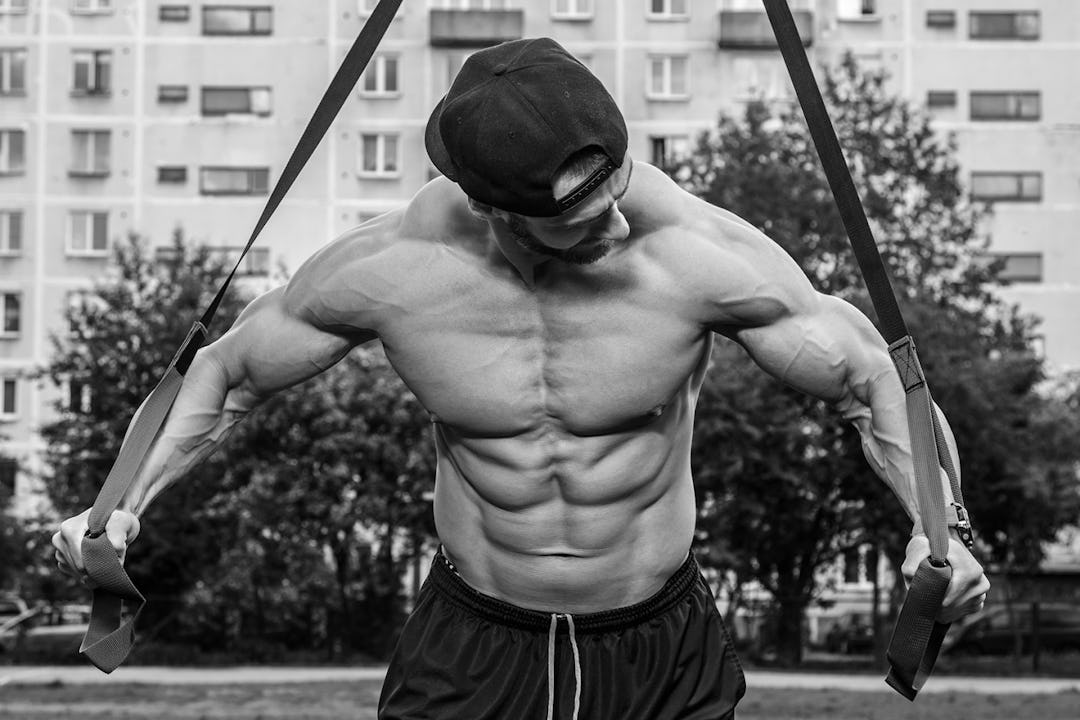

)

